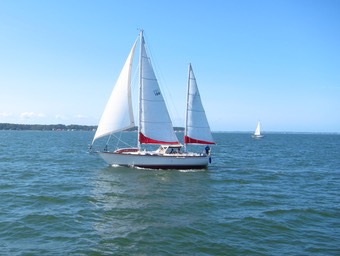The reciprocating saw (known to us as “Maxx Damnage”) let me make four long cuts in the space of a few hours.
Sadly, once we’re past the easy part, the new cuts involve less accessible places. And a less destructive saw.

The DeWalt reciprocating saw is good, but still doesn’t have the tight clearance the Fein Multimaster FMM250Q does.
I’ve got one of the semi-circular blades and I’m learning how to cut along the line over and over again until the blade finally pokes through the metal. It’s important to let the saw do the work and not force it.
The tank seems like it’s 10-gauge aluminum. The ABYC standard is 0.090″ to 0.125″. I haven’t measured, because it doesn’t really matter.
What does matter is that is’s slow going.
Today I made two 21” cuts to clean up the opening.

The process is loud. I mean “hearing protection required” loud.
After all, the aluminum is a vast resonating surface, connected to the hull of the boat, which is an even more vast resonant structure.
I spent time laying down, reaching into the tank. I don’t think I can reach up under the top all the way to the front of the tank. The tool is heavy and it’s a long reach.
I’ve ordered some of the larger size (4″) semi-circular blades for the Fein tool. These are described as suitable for thicker, non-ferrous material. If they work, I’m going to use them to slice away as much of the lid as I can. Consistent with not dropping the saw. This means parts of the top may remain in place because they're nearly inaccessible.

I looked at using the reciprocating saw from underneath, but the blade would collide with the fiberglass structure above the tank and that would be very, very bad for saw control and blade life.
Two more cuts with the Fein tool and we can start looking at fitting cardboard mockups in there to see how much tankage we can assemble through the 21″×21″ hole.
Or.
If the new blades are dramatically better, I may try to remove more of the top of the tank.
Worst case is two plastic replacement tanks. One little pointy one forward and one big chonker that’s about the size of the hole, but slides aft a few inches, leaving a little gap right at the forward edge of the opening. The forward tank would be (almost) entirely hidden, but the aft tank would be visible and accessible.
The triangular space forward of the opening is awkward and small. I suspect it’s on the order of 6-8 gallons. From the leading edge of the opening after, there’s at least 50 gallons of space. But. Dropping tanks in to fill that space is a real puzzlement. I think I can fill it with some 3-D bits and pieces of tankage and plumbing. I’ll be drawing sketches while I wait for another weekend.
(If you check back to Water Tank Replacement, you’ll see a volume estimate based on partial measurements. My current predictions are still based on still-incomplete measurements. The plan evolves.)


